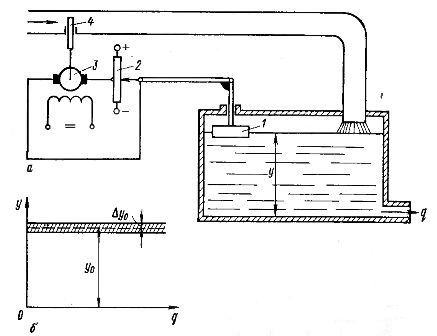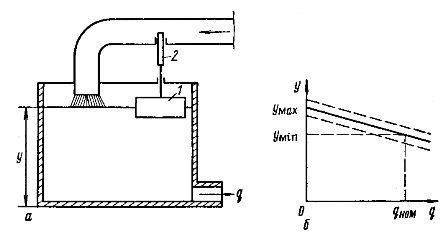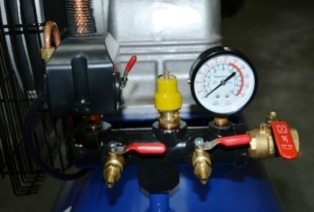Static and astatic regulation
 Astatic regulation is called such regulation, in which a constant value is maintained in a steady state at different values of a constant load: a controlled value equal to the set value.
Astatic regulation is called such regulation, in which a constant value is maintained in a steady state at different values of a constant load: a controlled value equal to the set value.
Astatism — a property of measurement systems or automatic control systems to reduce to zero errors in steady-state regulation or tracking, which occurred under the influence of control or disturbing influences on this system.
The law of reproduction — the algorithm of operation (hereinafter we will call it the control characteristic), without taking into account the insensitivity of the controller, is expressed by the equation y a = yo = const.
In the presence of insensitivity and it almost always exists y = yО +Δyoх where Δyo is the value of the insensitivity of the controller.
Consider the principle of operation of astatic and static regulators, using the example of operation of a water tank installed on the tower to supply consumers with water.
In fig. 1a shows a diagram of the astatic level control near the water in the tank.The float 1 through the lever is connected to the slider of the rheostat 2, with the help of which the DC motor 3, whenever the slider moves up or down from the middle position, starts to rotate in one direction or another and moves valve 4 (regulating body), until the given level of water in the tank will not be restored, that is, until the voltage applied to the armature circuit of the motor becomes equal to zero and an equilibrium state (equilibrium state) occurs.
This regime corresponds to a certain predetermined level of water in the tank, which for all equilibrium conditions remains strictly constant until the insensitivity of the controller. The insensitivity of the regulator in this case is determined by the presence of backlash in the joints and the starting voltage of the motor, which is different from zero.

Rice. 1. Scheme (a) and control characteristic (b) of the astatic regulation
If we denote the water flow through q, then the graphical representation of the control characteristic as a function of the flow rate q will correspond to the dependence shown in Fig. 1, b.
Fig. 1, but it can be seen that the regulating body (valve 4) and the sensitive element (float 1) do not have a direct connection, but are connected to each other through a DC motor and a rheostat, therefore this system is an indirect control system… Here every time, when the regulating element is rearranged in such a position that the controlled variable (water level in the tank) is returned at each load (water flow q) to a certain value. Devices that perform astatic regulation are called astatic regulators.
Along with astatic, static regulation is widely used in practice.
The regulation is called static control if the values of the controlled variable that are established after the end of the transient process at different constant load values will also assume different constant values depending on the load.
In fig. 2, a shows a diagram of the static regulation of the water level in the head tank. Float 1 acts directly on the regulating body — valve 2, therefore the regulator in this case will be a direct-acting regulator.
As the flow rate q of water increases, its level in the tank will begin to decrease, the float will lower and move the valve, increasing the cross section of the supply pipe and, accordingly, the amount of water entering through the pipe per unit time. In this case, the water level will begin to rise, raising the float and at the same time the valve.
Equilibrium will occur when the inflow of water is equal to its consumption. The greater the load, i.e. the flow rate q, the more the valve will be opened and therefore the lower the float will be in equilibrium. Therefore, in this scheme, as the load increases, the water level value (controlled value y) will decrease.

Rice. 2... Schematic (a) and control characteristic (b) of the static regulation
Devices that carry out static regulation are called static regulators... The control characteristic of the static regulator is expressed by the equation y = yО +Δy.
Static controllers do not maintain a strictly constant value of the controlled variable, but with an error called static error.
Static error is understood as the largest deviation of the controlled value when the load changes from zero to nominal, i.e. Δy = minds — ymv
In control theory, to characterize the degree of dependence of the deviation of the controlled value on the load, the concept of relative static error, or statism of regulation, is often used.
If the control characteristic is clear (Fig. 2, b), the static will be constant for all load values. The static value (b) of each static regulator can be determined as follows:
δ = (minds — ymv) / uWednesday,
where ums — the maximum value of the controlled variable corresponding to the load q = 0, ymv — the minimum value of the controlled variable corresponding to the load qnom, yCp =(ums — ymv) /2 — the value of the controlled variable taken as a base.
One of the values of the controlled variable umax, ymin, y can be taken as a base value. Avg, etc.
Static controllers, despite the fact that they are inherent in static error, are widely used because they are simple in design and provide stable operation in transient modes. Astatic regulators are prone to fluctuations and in most cases do not have the necessary stability without aids.

